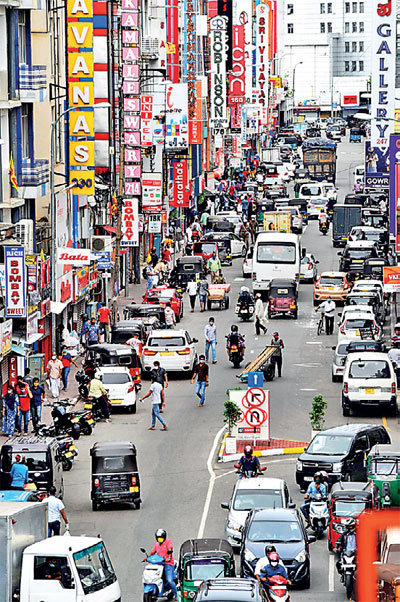Friday Jan 02, 2026
Friday Jan 02, 2026
Thursday, 3 February 2022 00:00 - - {{hitsCtrl.values.hits}}
By The Pathfinder Foundation
 with known net debt service payments of $ 6.6 billion this year and current fully usable official reserves of less than $ 1 billion (2-3 weeks of imports), Sri Lanka is confronted with both a cash flow problem and a debt problem. The liquidity problem is compounded by the fact that the only known additional external financing, at this point, are lines of credit from India ($ 1.5 b) and Pakistan ($ 200 m). These will certainly contain the depletion of reserves. They will not have a very material impact on the existing external financing gap, which is likely to be at least $ 7 billion this year, even with very optimistic assumptions about receipts from tourism, asset sales, remittances and FDI.
with known net debt service payments of $ 6.6 billion this year and current fully usable official reserves of less than $ 1 billion (2-3 weeks of imports), Sri Lanka is confronted with both a cash flow problem and a debt problem. The liquidity problem is compounded by the fact that the only known additional external financing, at this point, are lines of credit from India ($ 1.5 b) and Pakistan ($ 200 m). These will certainly contain the depletion of reserves. They will not have a very material impact on the existing external financing gap, which is likely to be at least $ 7 billion this year, even with very optimistic assumptions about receipts from tourism, asset sales, remittances and FDI.
With each passing day, the dollar illiquidity will worsen unless there are large inflows. These are currently not on the horizon. Some businesses are being scarred; others are having to close down. There will be some temporary reduction in the hardships being experienced by the people due to the Indian SWAP, the deferral of the Asian Clearing Union settlement and the lines of credit obtained in recent weeks. The intention of the Indian government to provide humanitarian support in this time of great need is very laudable. However, these generous initiatives will not serve to buy more than two- or three-months’ time. We need to do much more to help ourselves rather than relying on the goodwill of friendly neighbours, such as Bangladesh, India and Pakistan, whose per capita incomes are below ours.
Thanks to the high level of external debt, the country also has a solvency problem. This formidable challenge will not be resolved by a few bilateral sources of temporary financing. They do not alter the debt burden. The problem has been compounded as inflows have been less than anticipated. In its previous articles (see last paragraph), the Pathfinder Foundation has advocated: (1) an immediate announcement of a preemptive restructuring of external debt, (2) a very early and urgent approach to the IMF; and (3) bridging finance from friendly bilateral partners pending completion of the negotiations with creditors and the IMF which can take at least six months.
Debt restructuring, excluding multilateral debt, can save over $ 3 billion, during the first year. These dollars can be used to finance imports that meet the essential needs of the people and urgent requirements of businesses. An IMF program can trigger a combination of balance of payments financing and direct budgetary support from the World Bank and Asian Development Bank to the tune of $ 1.5-2.0 billion in the first year. The combined increases in $availability during the first 12 months will have a huge positive impact in resolving the problems currently being caused by dollar illiquidity.
However, there can be no gain without pain. The painful consequences of many years of indiscipline, resulting in the country living well beyond its means, cannot be wished away. An austerity program is inevitable. Its depth and duration can be mitigated by robust structural reforms that increase productivity/competitiveness and thereby strengthen the growth framework of the economy. This would increase output, employment and incomes. The policies adopted should also prioritise inclusiveness and sustainability.
A home-grown program needs to be developed to meet these objectives. It should also be credible enough to negotiate with the IMF and creditors. Such a program may include, inter alia, the following:
The above could, inter alia, be key elements of a home-grown reform program that can be the basis of negotiations with the IMF. It can also be credible enough to generate confidence among creditors. However, it is also important to accelerate the long over-due structural reforms to ensure that the above program, which is primarily focused on stabilisation, does not lead to a growth deficit. This has been a repeated problem with reform efforts in the past decades. The structural reforms to generate growth are very well known and relate to: factor markets (land, labour and capital); the investment climate; investment promotion; trade policy, including trade agreements; trade facilitation; education, training and skills development; and digitalisation.
There is much to be done, and done quickly, to avoid falling into the abyss.
(Previous Pathfinder articles in this series include: Lest we forget remembering the Pathfinder Beyond the Box: A New Economic Vision for Post; The Nightmare Scenario: A Default on Sovereign Debt; Sri Lanka has no choice but to Restructure External Debt: A Pathfinder Perspective; Pulling back from the precipice: A Pathfinder perspective. This is A Pathfinder Perspective issued by the Pathfinder Foundation and can be viewed on https://pathfinderfoundation.org.
Readers’ comments via email to [email protected] are welcome.)